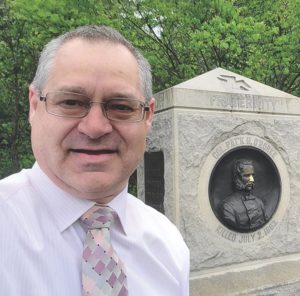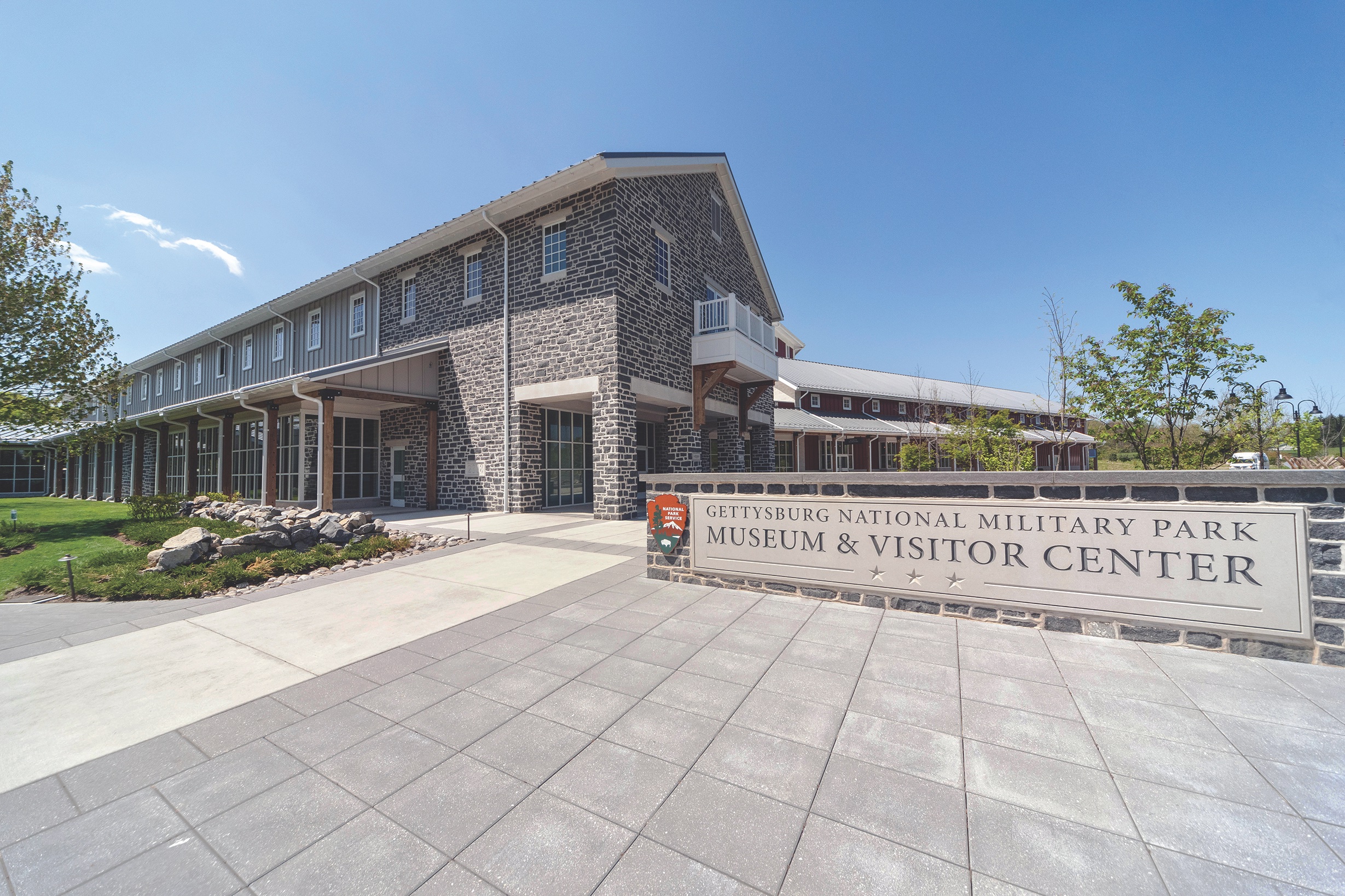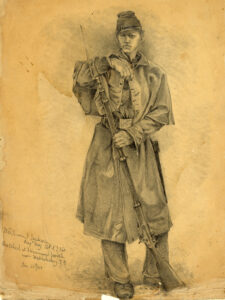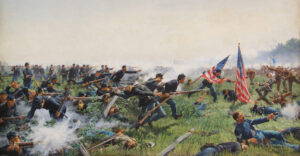In May 2021, Wayne Motts was named president and chief executive officer of the Gettysburg Foundation, an organization founded in 1989 to help preserve Gettysburg National Military Park. A lifelong aficionado of the Civil War, Motts began his career as a battlefield guide at Gettysburg in 1988. He also served as director of the Adams County Historical Society in Gettysburg and director of the National Museum of the Civil War in Harrisburg, Pa., before assuming his new post.
CWT: What is your new position and how did you get there?
WM: I’ve been a battlefield guide at Gettysburg National Military Park for 33 years, since 1988. I went to school for military history at Ohio State University and got a master’s degree in American History from Shippensburg University. Then I got museum jobs, and I became a curator. I was executive director for the Adams County Historical Society, which is here in Gettysburg. In 2012, I got a job at the National Museum for Civil War History in Harrisburg, where I was for nine years. In May 2021, I took the position as president and chief executive officer of the Gettysburg Foundation. I went from the second largest Civil War museum in the country to the largest public history venue in the world related to the Civil War, and I can’t tell you how honored I am to be here. As most people know, I was the boy wearing a kepi on the battlefield and now I get to make a difference at Gettysburg. It’s a big honor. I’ve got big shoes to fill all the way around.
CWT: Tell us about the Gettysburg Foundation’s mission and how it operates.
WM: I think a lot of people don’t know that the main National Park Service Visitor Center—the main visitor cen-
ter at Gettysburg National Military Park—is maintained, owned, and operated by the Gettysburg Foundation. It’s not owned by the federal government. We are a nonprofit philanthropic organization operating in partnership with the National Park Service to preserve Gettysburg National Military Park and the Eisenhower National Historic Site.
CWT: What is the scope of your duties?

WM: First of all, I have to be the chief person related to management of staff and operations. And then as part of those duties, I would say fundraising is an important part. I need to be the biggest cheerleader and advocate. Those fit hand in hand. You talk about the projects you’re working with the National Park Service to support, saying—hey, we would like you to consider a donation to this. And then, oh by the way, we are advocating for these things. I’ve been excited all my life about these things. I work very closely with Steve Sims, the superintendent of Gettysburg National Military Park. We’ve got a great partnership.
CWT: What do you see as your biggest challenges?
WM: Many people would say COVID would be the immediate challenge. But the longterm challenge is to continue attracting new visitors, attracting younger visitors, attracting a wide range of visitors from all over the country and the world. Probably 3-4 percent of the visitation to Gettysburg is international. We have to think about what stories we can tell. When I worked as a battlefield guide I had to focus on: How do you get people interested in the Civil War? You tell stories. In order for us to attract new, younger, diverse audiences, we need to tell a little different stories than what we’ve been telling. And it doesn’t mean we don’t tell stories we have in the past.
CWT: You have a new program oriented toward children, for example.
WM: My predecessor, David Malgee, who was a member of the board of directors and was the Gettysburg Foundation’s interim president until I got here in May, just did a wonderful job navigating our organization through some very difficult times. One of the exciting things that was planned even in the COVID time, was a children’s museum, basically K–5th grade, in the John Rupp House. John Rupp, a local tanner, lived on Baltimore Street during the time of the battle and at one point, Union troops were shooting from the front of his home at Confederates behind his home. We put a children’s museum inside there focusing on younger children during the battle [https://www.gettysburgfoundation.org/exhibits-tours-events/exhibits-
tours-events/children-of-gettysburg-
1863]. There is nothing like it in Gettysburg.
CWT: Tell me about the Friends of Gettysburg.
WM: The Friends of Gettysburg is the membership wing of the organization, so to speak. It began as a separate organization that then merged with the Gettysburg Foundation. We have thousands of members and supporters all over the country. They come to education programs we have. They donate to different causes that we have. We have volunteer work days that they come to. That’s a really important way that people can get involved and get materials about what we’re doing with the park.
CWT: What is in the works?
WM: A project that we’re hoping will open in spring of 2022 is the Lincoln train station, where Lincoln arrived in Gettysburg on November 18, 1863, the night before delivering the Gettysburg Address. It is owned by the Gettysburg Foundation, and we are working with a corporation in New York to turn that venue into an augmented reality experience. You will walk into the train station, put on a pair of goggles, and you will experience people involved in the Battle of Gettysburg. One civilian, one nurse, and one African American from the Gettysburg community, and one military service personnel. There is nothing like it in Gettysburg. We’ve also been assisting the National Park Service and raised funds for a multimillion-dollar NPS rehabilitation of Little Round Top, hopefully to start in the spring of 2022. The site will have to be closed for an extended time.
CWT: Do you have a wish list for future programming?
WM: I have a long personal list. One of the things I’m really excited about is, prior to COVID, we had a series of presentations by authors called Sacred Trust and we have not been able to have that for quite a number of years. We’re going to bring that back in July 2022. We’ll have 18 speakers and authors at that event. These are some of the best scholars in the world related to the Civil War. The National Park Service will be a co-sponsor. I should also mention that the Gettysburg Foundation owns and operates the George Spangler Farm. I think that is the best-preserved Civil War field hospital in the United States. And it was the 11th Army Corps field hospital at Gettysburg, and there were 1,900 wounded soldiers inside that property for about five weeks after the battle. That includes about 100 Confederate soldiers. We have public programs and living history out there during the summer season. People can look at the website [https://www.gettysburgfoundation.org/george-spangler-farm] to learn about it.
CWT: Have you had any big surprises so far?
WM: I usually go down to the visitor center twice a day if I am in the office to talk to visitors. I’m always surprised at the excitement that everybody has to visit this place. They don’t know who I am, and they say they can’t wait to get back. It is fascinating to understand why people are coming here.Ο
Interview conducted by Sarah Richardson.





